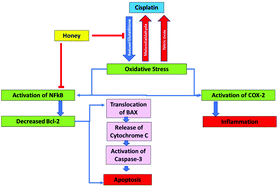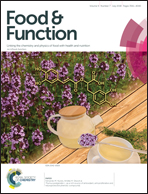Honey protects against cisplatin-induced hepatic and renal toxicity through inhibition of NF-κB-mediated COX-2 expression and the oxidative stress dependent BAX/Bcl-2/caspase-3 apoptotic pathway
Abstract
The protective effects of both manuka and talh honeys were assessed using a rat model of cisplatin (CISP)-induced hepatotoxicity and nephrotoxicity. The results revealed that both honeys exerted a protective effect against CISP-induced hepatotoxicity and nephrotoxicity as demonstrated by decreasing liver and kidney function. Manuka honey also prevented CISP-induced histopathological changes observed in the liver and decreased the changes seen in the kidneys. Talh honey decreased CISP-induced liver histopathological changes but had no effect on CISP-induced kidney histopathological changes. Both honeys reduced the oxidative stress in the liver. Conversely, they have no effect on kidney oxidative stress, except that manuka honey increased CAT activity. GC-MS analysis showed the presence of the antioxidant octadecanoic acid in talh honey while heneicosane and hydrocinnamic acid were present at a higher content in manuka honey. The molecular mechanism was to limit the expression of inflammatory signals, including COX-2 and NF-κB, and the expression of the apoptotic signal, BAX and caspase-3 while inducing Bcl-2 expression.



 Please wait while we load your content...
Please wait while we load your content...